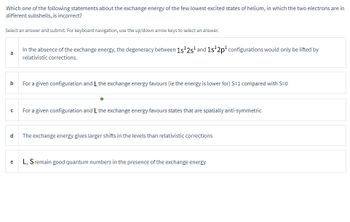Question

Transcribed Image Text:Which one of the following statements about the exchange energy of the few lowest excited states of helium, in which the two electrons are in
different subshells, is incorrect?
Select an answer and submit. For keyboard navigation, use the up/down arrow keys to select an answer.
b
с
d
e
In the absence of the exchange energy, the degeneracy between 1s¹2s¹ and 1s¹2p¹ configurations would only be lifted by
relativistic corrections.
For a given configuration and L the exchange energy favours (ie the energy is lower for) S-1 compared with S=0
O
For a given configuration and L the exchange energy favours states that are spatially anti-symmetric
The exchange energy gives larger shifts in the levels than relativistic corrections
L, S remain good quantum numbers in the presence of the exchange energy
Expert Solution
This question has been solved!
Explore an expertly crafted, step-by-step solution for a thorough understanding of key concepts.
Step by stepSolved in 2 steps

Knowledge Booster
Similar questions
- AK éléctron in a hydrogen atom makes a transition from the state n= 12 to the state n= 2. Give the wavelength of the photon emitted during this transition in units of nm. Round your answer to 2 significant figures. Add your answerarrow_forwardPlease, I want to solve the question correctly, clearly and conciselyarrow_forwardIn the following questions, we will use quantum states made up of the hydrogen energy eigenstates: Q1: Consider the election in a hydrogen atom to initially be in the state: F A. B. C. a) What is the probability of measuring the energy of this state and obtaining E₂? √3 √ vnim (r0,0)=R(r)Y," (0,0) always Y(t = 0) = √3 R₁OYO at t=0 but something different at t>0 ² at t=0 but something different at t>0 D. always 3 + E. Something else. b) Explain your answer. R₂₁ + R32Y₂¹arrow_forward
- could you also explain to me how you come up with question A?arrow_forwardDon’t copy the old answerarrow_forwardA rectangular corral of widths Lx = L and Ly = 2L contains seven electrons. What is the energy of (a) the first excited state, (b) the second excited state, and (c) the third excited state of the system? Assume that the electrons do not interact with one another, and do not neglect spin. State your answers in terms of the given variables, using hand me (electron mass) when needed.arrow_forward
arrow_back_ios
arrow_forward_ios